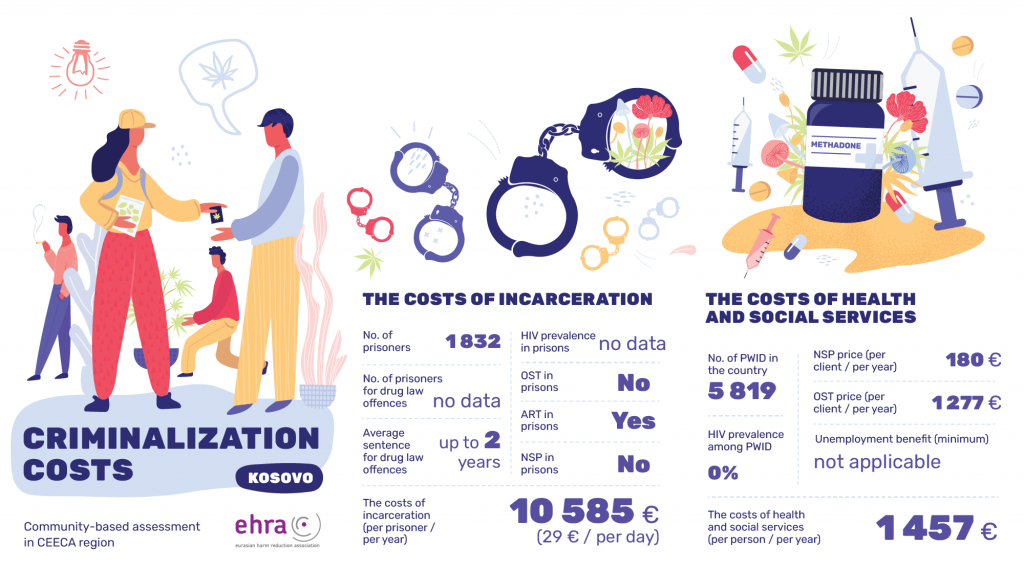As of 2020, there were 1,832 prisoners held in the territory of Kosovo [1]. Recent data is unavailable for the number of prisoners held for drug law offences, but in 2017 the number of new inmates incarcerated for drug law offices was 118, with such offences resulting in a term of imprisonment of up to 2 year [2]. No data is available as to the HIV prevalence among prisoners, although one case of HIV has been reported in the past [3], although antiretroviral therapy (ART) is available in prisons [4]. However, neither opioid substitution therapy (OST) nor needle/syringe programmes (NSP) are available in prison [5].
Incarceration costs the Government of Kosovo €10,585 per prisoner, per year, or €29 per day [6].
There were estimated to be 5,819 people who inject drugs in Kosovo in the period 2017-2018 and no detected HIV among them at that time [7]. NSP costs €180 per client, per year, and OST costs around €1,277 per client, per year [8]. No unemployment benefit currently exists in Kosovo but since 2016 there has been a ‘benefit of last-resort’ in the form of social assistance paid at €91 per person, per month [9].
Therefore, providing assistance to a person who injects opioids in community settings would cost the Government of Kosovo €1,457 per year, whereas to imprison that person for drug use and possession costs the Government €10,585 per year. Consequently, by decriminalising drug use and possession, the Government of Kosovo could save itself €9,128 per person.
[1] World Prison Brief. Belarus. London; Institute for Crime & Justice Policy Research, University of London. https://www.prisonstudies.org/country/kosovokosova (accessed 8 August 2021).
[2] Kosovo Agency of Statistics (KAS). Statistics of Jurisprudence for Adult Persons, 2017. Pristina; KAS, September 2018. https://ask.rks-gov.net/media/4367/statistics-of-jurisprudence-for-adults-2017.pdf (accessed 8 August 2021).
[3] Stöver H, Teltzrow R (eds.). Drug-Treatment Systems in Prisons in Eastern and South-East Europe. Strasbourg; Council of Europe, June 2017. https://www.emcdda.europa.eu/system/files/attachments/5502/Drug-treatment_systems_in_prisons_in_Eastern_and_South-East_Europe.pdf (accessed 3 August 2021).
[4] Harm Reduction International (HRI). Global State of Harm Reduction 2020, Regional Overview 2.2 Eurasia. London; HRI, 2021. https://www.hri.global/files/2020/10/26/Global_State_HRI_2020_2_2_Eurasia_FA_WEB.pdf (accessed 3 August 2021).
[5] Ibid.
[6] Information submitted by a national partner from data received from the Kosovo Correctional Services.
[7] Gashi L, Deva E, Gexha Bunjaku D. Integrated Biological and Behavioral Surveillance among Key Populations in Kosovo, Second Generation Surveillance of HIV/AIDS (Round IV), 2017-2018. Pristina; National Institute of Public Health, 2019. http://kcdf.org/wp-content/uploads/2019/05/IBBS-report-Kosovo-2018-anglisht-FINAL.pdf (accessed 8 August 2021).
[8] Information submitted by national partners.
[9] The World Bank. Social Protection and Health Expenditure Note, Kosovo. Washington, D.C.; World Bank Group, May 2018. https://openknowledge.worldbank.org/bitstream/handle/10986/32094/Kosovo-Social-Protection-and-Health-Expenditure-Note.pdf (accessed 8 August 2021).

